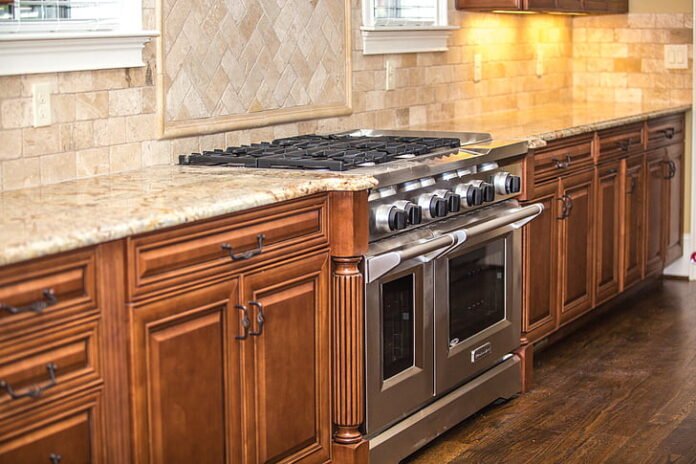Last Updated on May 16, 2025 by Rida Gul
Table of Contents
Introduction
Staining is a popular and effective choice when it comes to enhancing the look of your kitchen cabinets. Stained kitchen cabinets not only improve the aesthetic appeal of your cabinetry but also offer protection and durability. Whether you’re looking to renovate your home or maintain the beauty of your cabinets, understanding the types of stains, the staining process, and how to care for stained cabinets is essential. In this guide, we’ll explore everything you need to know about cabinet stains, helping you make informed decisions about your home.
Types of Stained Kitchen Cabinets
Cabinet stains come in various types, each offering a unique finish and application process. Here are the most common types:
Oil-Based Stains
Oil-based stains are popular for their deep penetration and long-lasting finish. They take longer to dry and often require additional ventilation during application due to the strong fumes they emit.
Water-Based Stains
Water-based stains are known for their quick drying times and low odor, making them a more eco-friendly choice. Water-based stains are best for lighter wood tones, as they can sometimes appear less rich on darker woods.
Gel Stains
Gel stains are thick and are typically used for non-porous surfaces or when refinishing cabinets that already have a finish. They don’t penetrate as deeply into the wood but provide an even color, making them ideal for vertical surfaces like cabinet doors.
Lacquer Stains
Lacquer stains offer a durable and glossy finish. Lacquer stains give cabinets a sleek, polished look but require more skill to apply correctly.
Varnish Stain
Varnish stains are similar to oil stains, but there is one difference. They include varnish rather than oil. That means they dry quickly, eliminating the need to wipe away excess to get an even coat.
How to Choose the Right Stain for Your Cabinets?
Choosing the right stain for your cabinets depends on several factors, including the type of wood, the finish you want, and your skill level. Here are some considerations to help you select the best stain:
- Wood Type
The type of wood your cabinets are made from plays a significant role in how the stain will appear. Some woods, like oak and cherry, absorb stains deeply, resulting in rich, dark hues. Others, like maple or pine, may appear blotchy or uneven if not properly prepared.
- Desired Finish
Oil-based stains are ideal for achieving rich, deep colors, while water-based or gel stains are better for lighter, more transparent finishes.
- Application Method
If you’re a DIY enthusiast, water-based stains are easier to handle and clean up compared to oil-based or lacquer stains. However, if you’re comfortable using professional tools like sprayers, lacquer stains may offer the high-gloss finish you’re looking for.
How to Stained Kitchen Cabinets?
Staining your cabinets involves a precise process to ensure an even, professional-quality finish. Below is a general guide to staining cabinets:
Materials you’ll need
- Microfiber cloths
- Protective plastic gloves
- Wood treatment
- Long-haired, soft bristle paint brush
- Steel wool
- Stain
- TSP (Trisodium Phosphate)
- Fine-grit sandpaper
Preparation
Start by removing the cabinet doors, drawers, and hardware. Clean the surfaces thoroughly to remove dirt, grease, and old finishes. Sand the cabinets lightly with fine-grit sandpaper to create a smooth surface for the stain to adhere to.
Apply Wood Conditioner (Optional)
For certain types of wood, especially softwoods like pine, applying a wood conditioner helps the stain absorb more evenly. This step prevents blotchiness and ensures a consistent finish.
Apply the Stain
Using a brush or cloth, apply the stain in the direction of the wood grain. For oil-based stains, use a brush for better penetration. Water-based stains are best applied with a cloth to avoid streaking. Allow the stain to sit for a few minutes before wiping off the excess with a clean cloth.
Let the Stain Dry
Allow the stain to dry according to the manufacturer’s instructions. Oil-based stains typically require 6-8 hours, while water-based stains dry in about 2-4 hours.
Apply a Top Coat
Once the stain is completely dry, apply a protective top coat such as polyurethane, varnish, or lacquer. This seals the stain, adds durability, and enhances the appearance of the wood. You may need to apply multiple coats, sanding lightly between each coat.
Reinstall Hardware
After the top coat has dried, reattach the hardware, and reinstall the cabinet doors and drawers.
Is it difficult to Stained Kitchen Cabinets?
It is not difficult to stain kitchen cabinets; most DIYers can do the job correctly. The key to success is good and thorough preparation, using the correct wood stain and brush for application, and applying a top coat if necessary. If you’re not sure about staining wood kitchen cabinets in place, removing the doors and drawer fronts and staining them flat can yield superior results.
What is the best Stained Kitchen Cabinets?
The best stains for kitchen cabinets are water-based, but make sure your wood stain matches your wood finish for good results.
Caring for Stained Cabinets
To keep your stained cabinets looking their best, proper care and maintenance are essential. Wipe down your cabinets regularly with a soft, damp cloth to remove dust and debris. For minor scratches or scuffs, you can use a matching touch-up stain or marker to fill in the damaged areas. Depending on the quality of the original finish and the level of wear, your cabinets may need to be re-stained every few years. This will restore their beauty and protect them from further damage.
Conclusion
Stained kitchen cabinets offer a beautiful way to enhance the look and feel of your kitchen. By understanding the different types of stains, the application process, and how to care for stained cabinets, you can achieve a professional and long-lasting finish. Whether you’re tackling a DIY project or hiring a professional, staining your cabinets can transform your space, adding both style and value to your home.
Apart from that if you want to know about “Choosing the Perfect Flooring for Your Stairs” then please visit our “Home Improvement” Category.
FAQs
Yes, if you want an extremely durable finish. Staining kitchen cabinets allows you to easily touch up over time, as any marks or scuffs can be swiftly covered up.
Yes, you can stain over existing kitchen cabinets, but you must first remove all traces of the original finish in order to achieve the best and most professional results.
Both stained and painted cabinets can be durable if sealed with the appropriate top coat. However, stained cabinets tend to show wear and scratches less than painted ones.



























